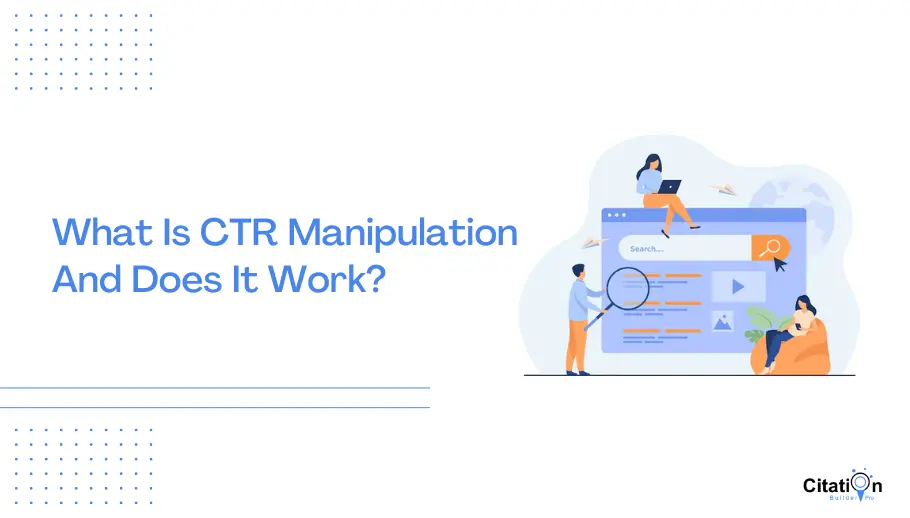Supercharge Your Link Structure Efforts with LinkDaddy CTR Manipulation Expertise
Wiki Article
Maximizing Organic Click-Through Fees With CTR Adjustment
The optimization of natural click-through rates (CTR) is a nuanced endeavor that hinges on understanding both user psychology and efficient web content discussion. The landscape is raging with misunderstandings and oversimplifications regarding what really drives CTR.Recognizing Click-Through Fees
Recognizing click-through rates (CTR) is necessary for evaluating the performance of on the internet advertising techniques. CTR determines the percent of individuals that click a certain link or ad compared to the complete variety of customers who view it. A greater CTR shows that the content is engaging and appropriate to the target audience, while a reduced CTR may signify a need for optimization.To determine CTR, divide the variety of clicks by the variety of impressions and multiply by 100. If an advertisement gets 300 clicks out of 10,000 impressions, the CTR would be 3%. This statistics is critical for evaluating various elements of digital advertising and marketing, including search engine optimization (SEO), email projects, and social networks advertising.
In addition, analyzing CTR helps marketers determine which techniques produce the very best outcomes and which require refinement. By focusing on enhancing CTR, businesses can enhance their material's visibility and efficiency, resulting in raised website traffic and prospective conversions. Understanding the nuances of CTR is fundamental for any marketer intending to optimize their on-line existence and maximize roi (ROI)

The Psychology of User Habits
Customer actions is substantially affected by mental variables that dictate exactly how individuals connect with on-line web content. Understanding these elements is important for optimizing click-through prices (CTR) in natural search outcomes.Emotional reactions additionally dramatically influence customer behavior. Web content that reverberates psychologically can activate a feeling of necessity or inquisitiveness, triggering customers to click. Furthermore, social evidence-- such as user reviews or rankings-- can enhance trust and urge involvement, as individuals typically aim to the actions of others to inform their very own decisions.
Additionally, the concept of scarcity can drive clicks - LinkDaddy CTR Manipulation. Limited-time offers or unique material produce a fear of missing out (FOMO), engaging customers to act swiftly. Comprehending these psychological vehicle drivers enables marketers to develop even more engaging content that reverberates with their target market
Reliable CTR Manipulation Strategies
Leveraging mental insights can substantially improve click-through prices (CTR) with targeted control techniques. One of the most efficient approaches is the use of compelling headings that stimulate inquisitiveness or seriousness. Phrasing titles as questions or including numbers can attract even more focus, prompting individuals to click.One more technique involves maximizing meta summaries to produce a sense of significance and immediacy. By clearly detailing the advantages or options supplied in the content, you can engage potential visitors and persuade them to click. In addition, using power words-- such as "special," "shown," or "free"-- can boost the charm of your material.
Aesthetic elements also play an important role. Including eye-catching images or thumbnails can attract customers in and boost CTR. A/B screening various visuals can assist identify which images resonate finest with your target market.
Finally, making sure that your content assures deliverable worth leads to higher CTR. They are more most likely to engage when individuals regard that clicking will provide them with meaningful understandings or services. By employing these strategies attentively, marketers can effectively control CTR to their advantage while keeping ethical standards.
Usual Misconceptions Concerning CTR
A number of false impressions surround click-through prices (CTR) that can lead marketing professionals to make misguided choices. One widespread myth is that a greater CTR constantly translates to far better performance. While a high CTR suggests that more customers are clicking, it does not assure conversions or sales. Eventually, the performance of traffic depends on the quality of the landing web page and the significance of the content.One more typical idea is that CTR is an isolated metric. In fact, CTR should be assessed combined with other efficiency indicators, such as bounce price and conversion price, to get an all natural view of project success.
Furthermore, some marketers presume that optimizing for CTR alone suffices. Nevertheless, focusing solely on CTR can cause clickbait strategies that might draw in clicks yet stop working to involve users meaningfully. This strategy can hurt brand track record and lead to lower retention prices
Finally, there is a concept that CTR techniques are widely efficient. The truth is that optimal CTR strategies can vary significantly across markets and target audiences, requiring tailored approaches for different market sectors. Understanding these myths is crucial for creating efficient CTR techniques that align with overarching advertising and marketing objectives.
Determining CTR Success
Although high click-through prices (CTR) can suggest successful engagement with content, determining their true success requires a detailed evaluation of a number of aspects. Initially, it is important to recognize the context in which the CTR is attained. For instance, a high CTR on a deceptive title may not equate to purposeful involvement or conversions, inevitably reflecting poorly on the brand's credibility.Second, reviewing the source of web traffic is critical. Organic website traffic from online search engine can indicate a durable material approach, while clicks from pointless resources might indicate an absence of targeting. Furthermore, important source measuring the succeeding customer habits is essential; evaluating metrics such as bounce price, time invested in page, and conversion prices can supply much deeper understandings into the quality of the involvement started by the CTR.

Verdict

The optimization of natural click-through prices (CTR) is a nuanced venture that hinges on recognizing both user psychology and reliable content presentation. CTR gauges the percent of individuals that click on a details web link or ad contrasted to the complete number of users who watch it. A greater CTR shows that the material is engaging and appropriate to the target audience, while a lower CTR may signal a requirement for optimization.
Concentrating exclusively on CTR great post to read can lead to clickbait methods that may bring in clicks but fail to engage customers meaningfully. Furthermore, gauging the succeeding user behavior is essential; evaluating metrics such as bounce price, time spent on web page, and conversion prices can supply deeper insights into the quality of the involvement launched by the CTR.
Report this wiki page